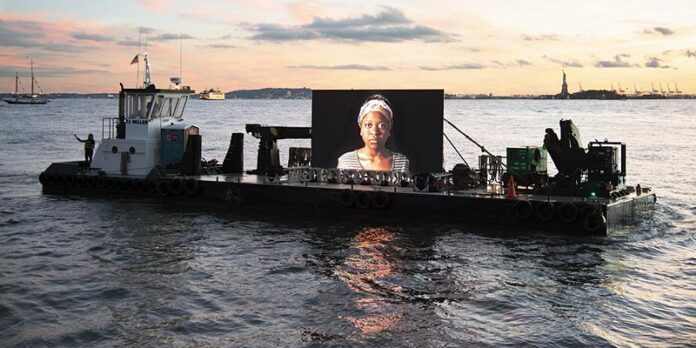As refugees on small boats have fled countries like Cuba, Laos, Cambodia, Vietnam, and Syria, “boat people” have been caught in the cross-fire of international relations, government bureaucracy, and xenophobia.
At dusk on September 17-19, BOXBLUR and Immersive Arts Alliance presented New York-based artist Shimon Attie’s “Night Watch,” (2018 and 2021) a 20 foot LCD screen mounted to a barge that traveled along the shoreline of the San Francisco Bay. As a site-specific event and video installation, the work features 12 video portraits of individuals from Nigeria, Honduras, Columbia, Russia, Kazakhstan, Jamaica, and Peru who have obtained political asylum in recent years. As Attie thoughtfully balances the urgency of his content with a respect for this collaborators, the artist asks us to look at each other and our surroundings.
From the Fort Mason piers, on opening night September 17, the iconic Golden Gate Bridge sat in the background, approximately marking the edge between the Bay and the Pacific Ocean, and by extension, the edge of city and the rest of the world.
Additionally, in being sited in the Bay, the barge sat amid our history of military points, with Fort Mason, a decommissioned military site; Angel Island, historically the Pacific immigration hub and where Japanese were interred during World War II; and Alcatraz, government occupied land and a former prison. Contextualized on the water between islands, Attie’s work speaks to the ways in which governments contain, detain, and regulate the flow of people and islands are sites of destination and isolation.
When originally presented in 2018 in New York, “Night Watch” traveled along the Hudson and East River, passing by the Statue of Liberty and Ellis Island, the Eastern immigration hub largely for immigrants crossing the Atlantic Ocean. With the West Coast iteration of “Night Watch,” Attie bridges the historic immigration hubs of Ellis and Angel Islands.
Shot in luscious color against a stark black background, Attie’s larger-than-life portraits render the details and individuality of his subjects’ faces. As his collaborators individually walk forward to emerge out of blackness, they confront the crowds that have gathered along the shorefront. Staring inexpressively at the audience, the individuals are not performing gratitude in attaining asylum, nor the traumas of their journeys. In simply representing themselves, they poetically appear from and disappear into the blackness.
Attie’s video may be reduced to merely an experience of audiences and collaborators looking at each other, with nothing more happening, no culmination. Rather than being a point of criticism, Attie’s restraint indicates his mindfulness in not exploiting the individuals and their personal and political narratives, representation, and safety for his own artistic voice and the audience’s desire for action and resolution.
While Attie’s video is very quiet and simple, the project’s logistics are quite costly and grand. The most interesting question that “Night Watch” provokes coalesces in balancing the artwork’s “success,” frequently measured in the number of viewers and “buzz,” using media to make political work accessible beyond the “insider” art world, all while refraining from turning his collaborators into a spectacle. As we attempt to impose value judgements, artistic and ethical, the power of “Night Watch” is in its ability to frame our environment, force us to really look at each other, and examine the social and historical contexts in which we live.




